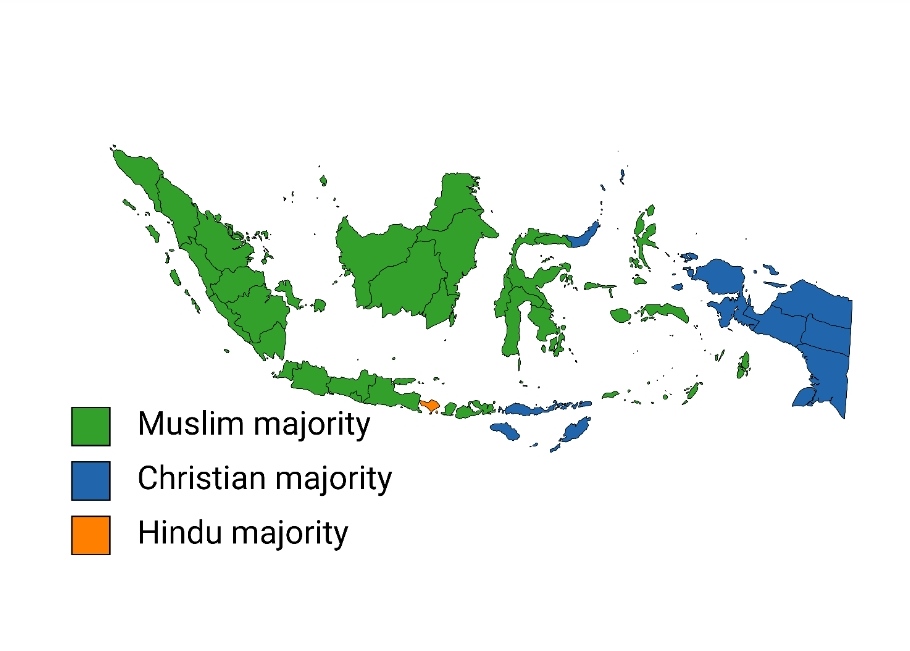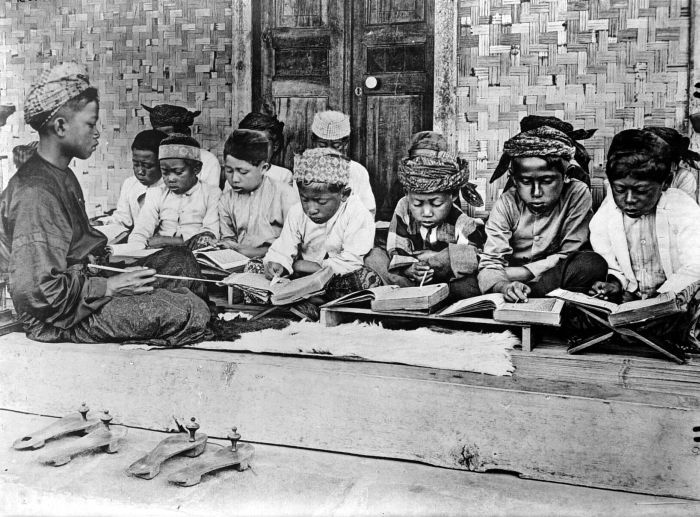|
Islam In Indonesia
Islam is the largest religion in Indonesia, with 86.7% of the Indonesian population identifying themselves as Muslim in a 2018 survey. Indonesia is the most populous Muslim-majority country, with approximately 231 million adherents. In terms of denomination, the overwhelming majority (98.8%) are Sunni Muslims, while 1-3 million (1%) are Shia, and are concentrated around Jakarta, and about 400,000 (0.2%) Ahmadi Muslims. In terms of schools of jurisprudence, based on demographic statistics, 99% of Indonesian Muslims mainly follow the Shafi'i school, although when asked, 56% does not adhere to any specific school. Trends of thought within Islam in Indonesia can be broadly categorized into two orientations: "modernism", which closely adheres to orthodox theology while embracing modern learning, and " traditionalism", which tends to follow the interpretations of local religious leaders and religious teachers at Islamic boarding schools ('' pesantren''). There is also a hi ... [...More Info...] [...Related Items...] OR: [Wikipedia] [Google] [Baidu] |
Menara Kudus Mosque
The Menara Kudus Mosque or Al-Aqsha Mosque is located in Kudus in the Indonesian province of Central Java. Dating from 1549, it is one of the oldest mosques in Indonesia, built at the time of Islam's spread through Java. The mosque preserves the tomb of Sunan Kudus, one of the nine Islamic saints of Java (the ''Wali Sanga''), and it is a popular pilgrimage point.Schoppert, P., Damais, S., ''Java Style'', 1997, Didier Millet, Paris, p. 207, Architecture It preserves pre-Islamic architectural forms such as old Javanese split doorways, ancient Hindu-Buddhist influenced Majapahit-style red brickwork, and a three-tired pyramidal roof. The most unusual feature is the brick minaret on which a pavilion shelters a large skin drum ('' bedug'') which is used to summon the faithful to prayer instead of the more common muezzin. Whereas a ''bedug'' normally hangs under the eaves of a mosque veranda, in the Kudus Mosque it sits in a tower like a Balinese Hindu temple ''kul-kul'' or sig ... [...More Info...] [...Related Items...] OR: [Wikipedia] [Google] [Baidu] |
Maddhab
A ( ar, مذهب ', , "way to act". pl. مَذَاهِب , ) is a school of thought within ''fiqh'' (Islamic jurisprudence). The major Sunni Mathhab are Hanafi, Maliki, Shafi'i and Hanbali. They emerged in the ninth and tenth centuries CE and by the twelfth century almost all jurists aligned themselves with a particular madhhab. These four schools recognize each other's validity and they have interacted in legal debate over the centuries. Rulings of these schools are followed across the Muslim world without exclusive regional restrictions, but they each came to dominate in different parts of the world. For example, the Maliki school is predominant in North and West Africa; the Hanafi school in South and Central Asia; the Shafi'i school in East Africa and Southeast Asia; and the Hanbali school in North and Central Arabia. The first centuries of Islam also witnessed a number of short-lived Sunni madhhabs. The Zahiri school, which is considered to be endangered, continues to exe ... [...More Info...] [...Related Items...] OR: [Wikipedia] [Google] [Baidu] |
Shia Muslims
Shīʿa Islam or Shīʿīsm is the second-largest branch of Islam. It holds that the Islamic prophet Muhammad designated ʿAlī ibn Abī Ṭālib as his successor (''khalīfa'') and the Imam (spiritual and political leader) after him, most notably at the event of Ghadir Khumm, but was prevented from succeeding Muhammad as the leader of the Muslims as a result of the choice made by some of Muhammad's other companions (''ṣaḥāba'') at Saqifah. This view primarily contrasts with that of Sunnī Islam, whose adherents believe that Muhammad did not appoint a successor before his death and consider Abū Bakr, who was appointed caliph by a group of senior Muslims at Saqifah, to be the first rightful (''rāshidūn'') caliph after Muhammad. Adherents of Shīʿa Islam are called Shīʿa Muslims, Shīʿītes, or simply Shīʿa or Shia. Shīʿa Islam is based on a ''ḥadīth'' report concerning Muhammad's pronouncement at Ghadir Khumm.Esposito, John. "What Everyone Needs to ... [...More Info...] [...Related Items...] OR: [Wikipedia] [Google] [Baidu] |
Sunni Muslims
Sunni Islam () is the largest branch of Islam, followed by 85–90% of the world's Muslims. Its name comes from the word '' Sunnah'', referring to the tradition of Muhammad. The differences between Sunni and Shia Muslims arose from a disagreement over the succession to Muhammad and subsequently acquired broader political significance, as well as theological and juridical dimensions. According to Sunni traditions, Muhammad left no successor and the participants of the Saqifah event appointed Abu Bakr as the next-in-line (the first caliph). This contrasts with the Shia view, which holds that Muhammad appointed his son-in-law and cousin Ali ibn Abi Talib as his successor. The adherents of Sunni Islam are referred to in Arabic as ("the people of the Sunnah and the community") or for short. In English, its doctrines and practices are sometimes called ''Sunnism'', while adherents are known as Sunni Muslims, Sunnis, Sunnites and Ahlus Sunnah. Sunni Islam is sometimes refer ... [...More Info...] [...Related Items...] OR: [Wikipedia] [Google] [Baidu] |
Indigenous Religions
Indigenous religions is a category used in the study of religion to demarcate the religious belief systems of communities described as being " indigenous". This category is often juxtaposed against others such as the " world religions" and "new religious movements". The term is commonly applied to a range of different belief systems across the Americas, Australasia, Asia, Africa, and Northern Europe, particularly to those practiced by communities living under the impact of colonialism. The term "indigenous religions" is usually applied to the localised belief systems of small-scale societies. These belief systems do not typically engage in proselytization, thus distinguishing them from movements like Christianity, Islam, and Buddhism that all seek converts and which are typically classified as "world religions"; unlike Judaism, even though it is often referred to as a “world religion”. They are also often characterised as being distinct from the "world religions" because t ... [...More Info...] [...Related Items...] OR: [Wikipedia] [Google] [Baidu] |
Islamic State
An Islamic state is a state that has a form of government based on Islamic law (sharia). As a term, it has been used to describe various historical polities and theories of governance in the Islamic world. As a translation of the Arabic term ''dawlah islāmiyyah'' ( ar, دولة إسلامية) it refers to a modern notion associated with political Islam (Islamism). Notable examples of historical Islamic states include the State of Medina, established by the Islamic prophet Muhammad, and the Arab Caliphate which continued under his successors and the Umayyads. The concept of the modern Islamic state has been articulated and promoted by ideologues such as Sayyid Rashid Rida, Mohammed Omar, Abul A'la Maududi, Ayatollah Ruhollah Khomeini, Israr Ahmed, Sayyid Qutb and Hassan al-Banna. Implementation of Islamic law plays an important role in modern theories of the Islamic state, as it did in classical Islamic political theories. However, most of the modern theories also ... [...More Info...] [...Related Items...] OR: [Wikipedia] [Google] [Baidu] |
Dutch East Indies
The Dutch East Indies, also known as the Netherlands East Indies ( nl, Nederlands(ch)-Indië; ), was a Dutch colony consisting of what is now Indonesia. It was formed from the nationalised trading posts of the Dutch East India Company, which came under the administration of the Dutch government in 1800. During the 19th century, the Dutch possessions and hegemony expanded, reaching the greatest territorial extent in the early 20th century. The Dutch East Indies was one of the most valuable colonies under European rule, and contributed to Dutch global prominence in spice and cash crop trade in the 19th to early 20th centuries. The colonial social order was based on rigid racial and social structures with a Dutch elite living separate from but linked to their native subjects. The term ''Indonesia'' came into use for the geographical location after 1880. In the early 20th century, local intellectuals began developing the concept of Indonesia as a nation state, and set the st ... [...More Info...] [...Related Items...] OR: [Wikipedia] [Google] [Baidu] |
Sufism
Sufism ( ar, ''aṣ-ṣūfiyya''), also known as Tasawwuf ( ''at-taṣawwuf''), is a mystic body of religious practice, found mainly within Sunni Islam but also within Shia Islam, which is characterized by a focus on Islamic spirituality, ritualism, asceticism and esotericism. It has been variously defined as "Islamic mysticism",Martin Lings, ''What is Sufism?'' (Lahore: Suhail Academy, 2005; first imp. 1983, second imp. 1999), p.15 "the mystical expression of Islamic faith", "the inward dimension of Islam", "the phenomenon of mysticism within Islam", the "main manifestation and the most important and central crystallization" of mystical practice in Islam, and "the interiorization and intensification of Islamic faith and practice". Practitioners of Sufism are referred to as "Sufis" (from , ), and historically typically belonged to "orders" known as (pl. ) – congregations formed around a grand who would be the last in a chain of successive teachers linking back to ... [...More Info...] [...Related Items...] OR: [Wikipedia] [Google] [Baidu] |
Arab
The Arabs (singular: Arab; singular ar, عَرَبِيٌّ, DIN 31635: , , plural ar, عَرَب, DIN 31635: , Arabic pronunciation: ), also known as the Arab people, are an ethnic group mainly inhabiting the Arab world in Western Asia, North Africa, the Horn of Africa, and the western Indian Ocean islands (including the Comoros). An Arab diaspora is also present around the world in significant numbers, most notably in the Americas, Western Europe, Turkey, Indonesia, and Iran. In modern usage, the term "Arab" tends to refer to those who both carry that ethnic identity and speak Arabic as their native language. This contrasts with the narrower traditional definition, which refers to the descendants of the tribes of Arabia. The religion of Islam was developed in Arabia, and Classical Arabic serves as the language of Islamic literature. 93 percent of Arabs are Muslims (the remainder consisted mostly of Arab Christians), while Arab Muslims are only 20 percent of the ... [...More Info...] [...Related Items...] OR: [Wikipedia] [Google] [Baidu] |
Pesantren
''Pesantren'', or ''pondok pesantren'', are Islamic boarding schools in Indonesia. They consist of pondok, mosque, santri, teaching of classical Islamic texts and Kyai.Zamakhsyari Dhofie''The Pesantren Tradition: A Study of the Role of the Kyai in the Maintenance of the Traditional Ideology of Islam in Java''Tempe, AZ: Arizona State University Program for Southeast Asian Studies Monograph Series. According to one popular tradition, the ''pesantren'' education system originated from traditional Javanese ''pondokan''; dormitories; ashram for Hindu or viharas for Buddhists to learn religious philosophies, martial arts and meditation. Institutions much like them are found across the Islamic world and are called ''pondok'' in Malaysia and Southern Thailand and '' madrasa Islamia'' (Islamic madrasa) in India and Pakistan and much of the Arabic-speaking world. The ''pesantren'' aim is to deepen knowledge of the Qurʾān, particularly through the study of Arabic, traditions of exegesi ... [...More Info...] [...Related Items...] OR: [Wikipedia] [Google] [Baidu] |
Traditionalism (Islam In Indonesia)
In the context of Muslim society in Indonesia, Traditionalism or traditionalist Islam refers to a religious strand which puts emphasis on preserving traditionally established local rituals and scholarship. Traditionalist Muslims refer to themselves as ''ahlusunnah wal jamaah'' or ''aswaja''.Bush, 2009. Traditionalism is often contrasted with modernism, which is inspired by modernity and rationalism. Traditionalism has been the most adhered Muslim religious orientation in the history of contemporary Muslim Indonesia. The extent of traditionalism widely overlaps with the influence of a socio-religious organization Nahdlatul Ulama, the biggest Muslim organization in Indonesia. Traditionalism is also a critical element within the Muslim intellectual movement known as Islam Nusantara. Usage of the term The division between "traditionalism" and "modernism" is widely used by both Indonesians and foreign academics to describe the chasm which has been existed among the contemporary Musli ... [...More Info...] [...Related Items...] OR: [Wikipedia] [Google] [Baidu] |







